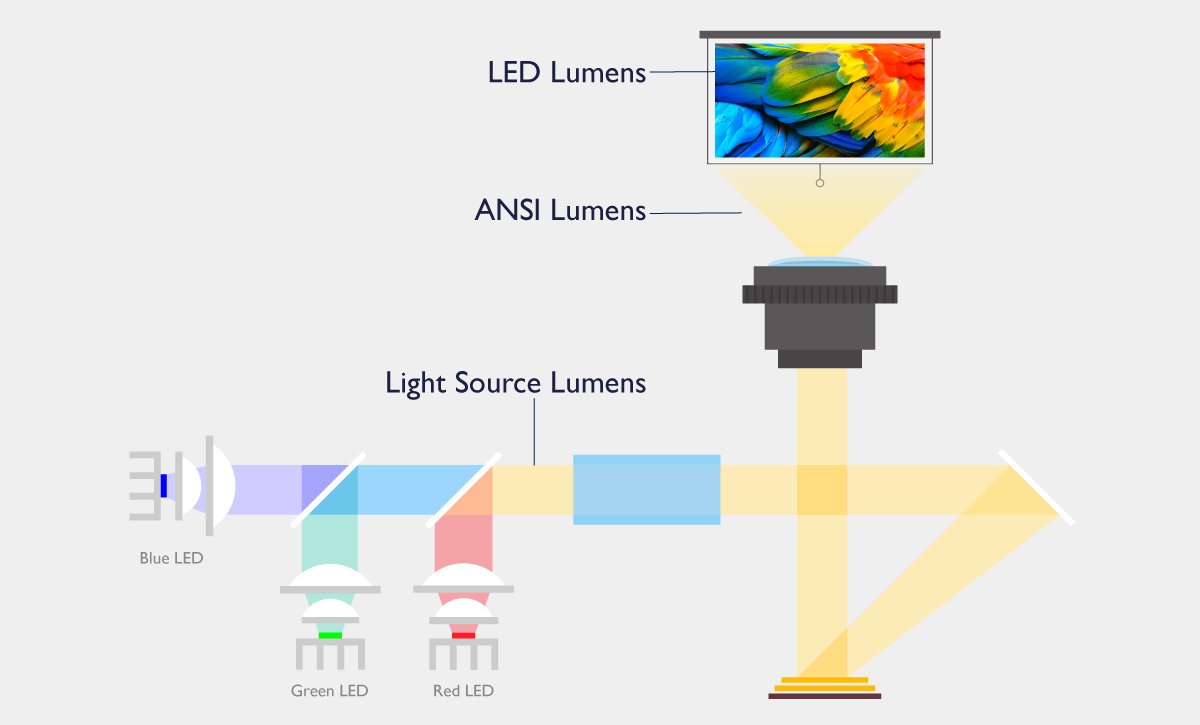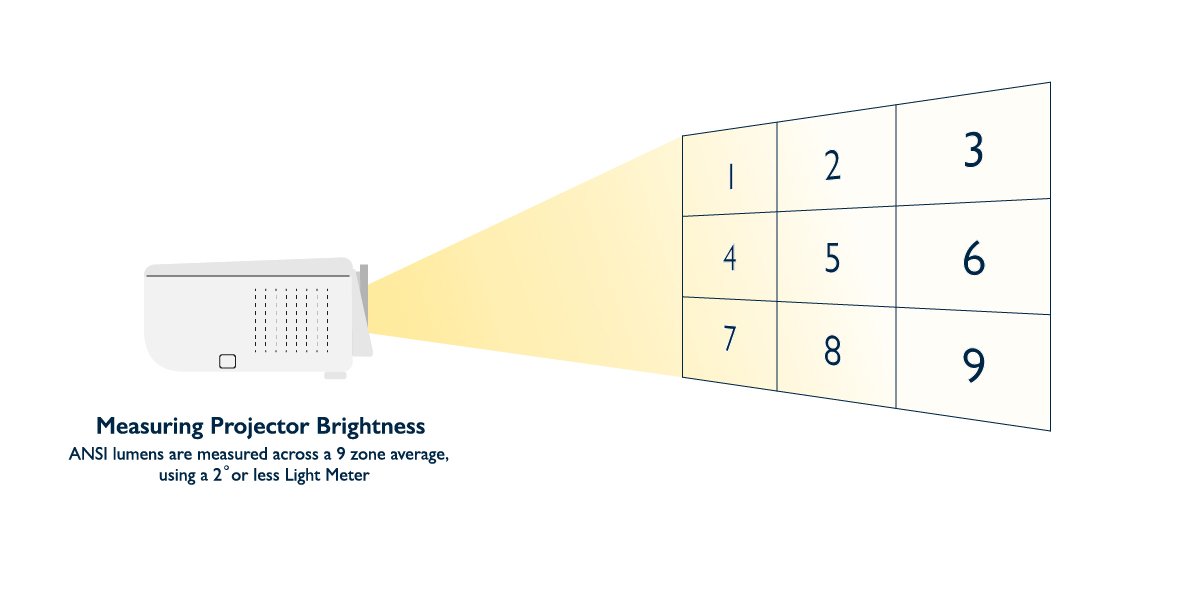

In the world of portable and pico projectors, the ability of the projector to produce clearly visible images in settings that can easily switch from a darkly lit room to the bright outdoors is of paramount importance. As a result, one of the key specs consumers look at when researching these types of projectors is their brightness value. But for even the most well-versed consumer, what are they to make of the fact that many times brightness specs vary wildly between different models, with different brands using different ways to label their projector’s brightness?

A very likely scenario a consumer might face is that Projector A may advertise a brightness value of 1,000 ANSI lumens, while the comparably-priced Projector B lists their brightness value at 2,400 LED lumens. Should a value so drastically higher than all the others, such as the one for Projector B, be trusted? What is the difference between the various lumens units, such as the ones used in our example (ANSI and LED)? How do each of these units stack up against each other, and is there a preferred unit to use? This article will seek to address each of these concerns so that you can have a better understanding of how different projectors market their brightness levels and thus make a more educated decision.
In the projector market, the most commonly used measures of brightness are ANSI Lumens, Lumens from light source, and LED Lumens. Though each method uses lumens – the standard brightness unit in the field of optics – as their basic unit of measure, they differ intrinsically in what they are actually measuring.

ANSI Lumen is the measure of the brightness of the light from a projector as defined by the American National Standards Institute (ANSI). It is typically measured by taking several brightness readings (in lumens) from various points on a projector’s white screen at a given distance and averaging them to determine the value.
Light source Lumen or brightness, as its name denotes, refers to the measured light output of a projector’s light source, which depending on the type of projector may be a lamp, LEDs, or lasers. Light source brightness differs from ANSI lumens in that ANSI lumens measures the brightness of the light projected by the projector (meaning the light that has undergone the imaging process of the projector), while light source brightness measures its brightness directly from the light source itself before it has been converted to an image by the projector’s other components.
LED brightness is a measure of brightness used by some manufacturers of LED projectors that takes into account what is known as the Helmholtz–Kohlrausch (HK) effect. The HK effect refers to the phenomenon whereby the human eye views highly-saturated colors as brighter than they objectively are. With the HK effect in mind, LED brightness acts as a value that tries to quantify, in actual lumens, the added brightness that results from the improved color performance of LED lights.

The HK effect is the phenomenon, mainly observed with colored lights, whereby the human eye views highly-saturated (or “purer”) colors as brighter than less saturated colors or even white light of the same luminance. Consequently, projectors that feature purer colors will produce for the viewer brighter images.


Given the almost inconsistent way each of these brightness values are used in product advertising, how then do we make sense of them and how they relate to each other? Can one value be directly compared to another? To start the discussion off we must first recognize that ANSI lumens is by far the most consistent and reliable brightness value used, as it is a standardized measure agreed upon by an internationally-recognized organization. From there, we can then discuss the other types of brightness measures in relation to ANSI lumens to understand how they are calculated for a deeper understanding of all of them.

For some consumers, the search for the brightest projector can often times boil down to just seeing a larger number attached to a projector’s brightness specs, which is a fact that some brands are acutely aware of. In order to entice these types of consumers these same brands will purposely list a high brightness value without distinguishing what type of brightness (ANSI, Light Source, or LED) they are referring to. This can lead consumers to have an inflated sense of said projector’s capabilities and in turn cause them to make a misguided choice. In these situations, we recommend that consumers always ensure that the type of brightness units they are relying on for a given projector are clearly stated, as well as sticking to well-known brands with established reputations.
Bluntly stated, brightness values of light source are always higher than ANSI lumen values. This is because, by definition, their calculations do not factor in any of the loss of brightness that occurs within the projector due to the imaging process. Their numbers are thereby free from the deflationary effects that the inner workings of the projector have on its brightness value (for example the percentage drop caused by the color wheel). Because of this, the light source lumens of a projector may be greater than the value of its ANSI lumens by a large factor.
ANSI Brightness = (L1+L2+L3+L4+L5+L6+L7+L8+L9)/9 (lux) x A (m^2)
A (Area) = W * H (m^2)

*Note: L10, L11, L12, L13 are located at 10% of the distance from corner itself to L5.
It is specified in ANSI IT7.228-1997.
In terms of a raw comparison of numbers, the LED lumen value for a projector is also always higher than its ANSI lumen. This is because, as discussed earlier, LED lumen measures seek to incorporate the additional brightness that results from the HK effect.

Based on various studies it has been asserted that the HK effect can result in a 1.3 to 2.4 time increase in brightness over a projector’s measured ANSI brightness. What this means is that, depending on how they rate the strength of the HK effect, a brand can calculate their projector’s LED brightness by simply multiplying its measured ANSI brightness by a factor of 1.3 to 2.4.

From the perspective of brands trying to market their projector, all of this makes the use of light source brightness or LED Lumens to market their projector that much more enticing as it ensures a number significantly higher than its ANSI counterpart. But should a consumer trust such practices?
In terms of light source brightness, the risk is in the fact that the inflated number does not accurately communicate the brightness of the final projected image (which is the reason for using a projector after all) and does not take into account the efficiency of the projector itself. Depending on the engineering of the projector, the image it produces could be drastically darker than its light source brightness leads one to believe.
The risk of trusting LED Lumens numbers is that even in the studies mentioned above, the quantification of the HK effect is a highly subjective practice. Choosing to multiply the ANSI lumens value by 2.4 as opposed to 1.3 to obtain the LED brightness can be completely arbitrary and not necessarily accurate.
In the end, the brightness measure that a consumer should always look for when deciding which projector to purchase is its ANSI Lumens. This is because, beyond being an internationally recognized standard, it is the most straightforward measurement which features none of the risks mentioned above.
